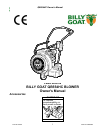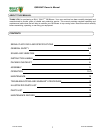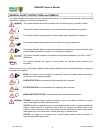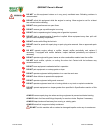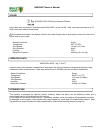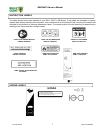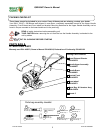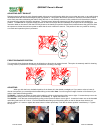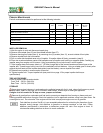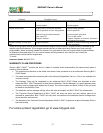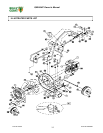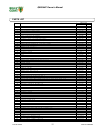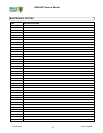
Part No 430316 Form No F062006C
12
QB554HC Owner’s Manual
MAINTENANCE
P
ERIODIC MAINTENANCE
Periodic maintenance should be performed at the following intervals:
Maintenance Operation Every
Use
Daily or Every
5 Hours
Every 25
Hours
Every 50
Hours
Every
100-150
Hours
Inspect for worn or damaged parts.
z
Check for excessive vibration
z
Inspect Impeller for cracks or damage
z
Engine (See Engine Manual)
z
Lubricate wheels
z
Inspect for loose parts.
z
IMPELLER REMOVAL
1. Wait for engine to cool and disconnect spark plug.
2. Remove front wheel (item 23),and front wheel bracket (item 27).
3. Remove housing front plate (item 4), by removing nine (9) screws (item 12), around outside of front plate.
4. Remove impeller bolt and lock washer.
5. Pull on center hub backplate area only of impeller. If impeller slides off freely, proceed to (step 8).
6. Place two crowbars between center hub backplate area of impeller and housing on opposite sides. Carefully pry
impeller away from engine until it loosens. Using a penetrating oil can help loosen a stuck impeller.
7. If the impeller does not loosen, obtain a 1” (25.4mm) longer bolt of the same diameter and thread type as the
impeller bolt. Thread longer bolt by hand into the crankshaft until bolt bottoms. Using a suitable gear or wheel puller
against the bolt head and the impeller back-plate (near the blades), remove impeller from shaft.
8. Reinstall new impeller in reverse order of removal.
9. Tighten impeller bolt. Torque impeller bolt (see parts list on page 15 for proper impeller bolt torque
specifications).
TIRE AIR PRESSURE
Check at regular intervals and maintain.
Front Tires - 50 Psi (344 kPa).
Rear Tires - 24 Psi (165 kPa).
STORAGE
Never store engine indoors or in enclosed poorly ventilated areas with fuel in tank, where fuel fumes may reach
an open flame, spark or pilot light, as on a furnace, water heater, clothes dryer or other gas appliance.
If engine is to be unused for 30 days or more, prepare as follows:
Remove all gasoline from carburetor and fuel tank to prevent gum deposits from forming on these parts and
causing possible malfunction of engine. Drain fuel outdoors, into an approved container, away from open flame. Be
sure engine is cool. Do not smoke. Run engine until fuel tank is empty and engine runs out of gasoline.
Fuel stabilizer (such as Sta-Bil
TM
) is an acceptable alternative for minimizing the formation of gum
deposits during storage. Add stabilizer to gasoline in storage container or fuel tank. Follow
stabilizer manufacturer’s instructions to determine proper mix ratio. Run engine at least 10
minutes after adding stabilizer to allow it to reach carburetor.



